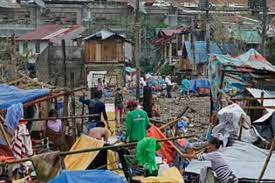More than 200 people have lost their lives due to this year’s most destructive storm in the Philippines. A large number of people are also missing and many towns and villages are not in contact. It was the most powerful storm to hit the Philippines this year. In this storm, winds were blowing at a speed of up to 195 kilometers per hour and there were strong gusts of wind up to 270 kilometers per hour. It has taken the lives of at least 208 people so far. 239 people are injured and 52 are missing. It is feared that the death toll will increase further.
Electricity and communication systems have come to a standstill in many towns and villages. A massive repair work is underway to restore the system again. Many people, like a giant monster, lost their lives due to falling trees and walls, sudden floods and landslides. A 57-year-old man was found hanging from a tree branch in the Negros Occidental province and a woman was blown away by the wind. Arlene Bag-Ao, the governor of Dinagat Islands, said that the storm on her island was more powerful than the storm of Haiyan in November 2013. “If it was like being washed in a washing machine, this time it was like a giant monster banging everywhere and picking up trees, three roofs, etc. and throwing it everywhere,” he said. More than 700,000 people were affected by the storm, of whom more than 400,000 people had to be taken to emergency shelters.
Thousands of people were rescued from the submerged villages. They had climbed on roofs and trees to escape from the rising water level. Relief efforts are going on, officials said that all efforts are being made to restore electricity system in 227 cities and towns. So far, electricity has been restored in only 21 areas. Mobil connections were also cut in more than 130 cities and towns. They have been re-added at 106 of these places.
Bagh-Aao and other officials were worried about running out of fuel in their areas. Due to running of temporary generators, the demand for fuel has increased significantly. Officials in several provinces also delivered vaccine doses for widespread vaccination. The Philippines, located between the Pacific Ocean and the South China Sea, experiences about 20 small and large storms every year. It also falls in an active “Ring of Fire” area for earthquakes, due to which it is considered the most disaster prone area in the world.
 Indian Thought Latest News & Views
Indian Thought Latest News & Views



